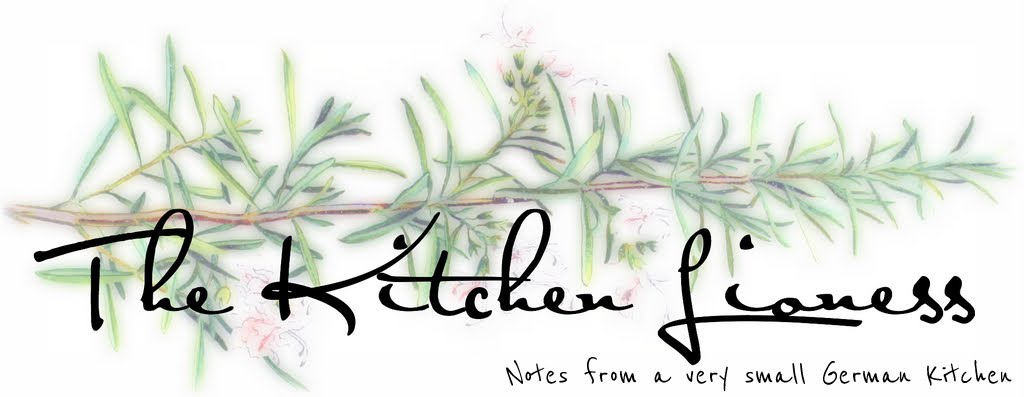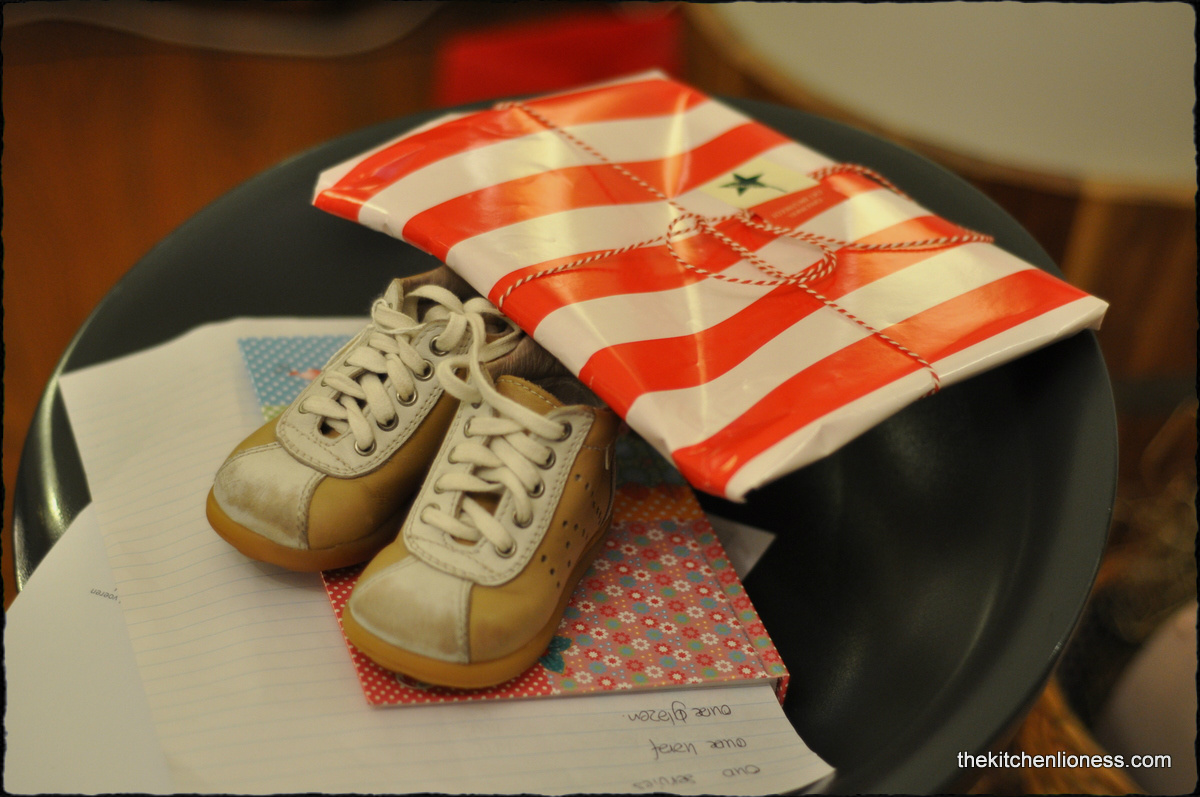It is always such a joy to find these types of wonderful places by chance. Like the „Café de Kiekoet“ in Maastricht (NL), that we basically stumbled upon when we visited Maastricht a few weeks back. This is an utterly charming café and gift shop, perfect not only for finding a gift for that someone special but also for enjoying a cup of coffee or tea and some waffles on the outside terrace at the back of the store.
The shop owners (Michelle Smeets and Truus Cobben) have a wonderful concept for their lovely store. They carry regional products and gifts from the area of Maastricht (Maastrichte Producten), as well as vintage collectors items (brocante). Personally, I find this particular mix utterly delightful.
The
Regular Collection of the store includes must-haves such as handmade
Maastricht mustards (
Limburgse mosterd) and specialty jams and jellies from
Adriaan de Smaakmaker (for more info, please look
here), as well as
Apostelhoeve wine from a vineyard in Limburg (for more info, please go
here) and those famous
Maastricht Chocolate Stars (
Chocolade sterretjes) in white, milk or dark chocolate.
Then there is the
Changing Collection, whith different offerings every couple of months. You could find Maastricht Legos, kitchen-towels, tea-towels, bath-towels, baby onesies, kitchen posters, coffee and tea cups, mugs, notebooks, key chains, all with that famous Maastricht star logo.
And then there is the
Vintage Collection, which includes all those lovely things that make a blogger`s heart do somersaults. It varies also depending on the season and whet the owners were able to find at antique sales and flea markets. You might find tea-pots, cups, plates, spice jars, and soup tureens with delicate flowery designs. Or coffeetables, tins, glasses, jewellry and even childrens´ furniture.

The official flag of Maastricht, the capital city of the province of Limburg, in the Netherlands is a red vertical surface with a five-pointed star. So it comes as no surprise that the star of Maastricht (or as the locals call it "Mestreech") is proudly displayed throughout the store on a number of different products and can also be found on the lovely tables that grace the outside terrace - inviting you to enjoy a local apple juice...
...or enjoy a steaming cup of coffee that is served in these or other adorable vintage cups, that are placed on vintage serving platters and accentuated with adorable spoons, all of which you can also buy at the store.
Of course, a coffee break from all that that shopping would not be complete without those delicious crunchy
Maastricht butter cookies that are shaped like the Maastricht coat of arms (
Mestreechter keukskes or k
oekjes) produced by the
Pâtisserie Royale also located in the city (you can take a look
here for more information on these fabulous cookies).
The outside terrace of the Café is very lovingly decorated - you can find a dark green old window frame like this one...
...or the wonderful flower arangements (of course, being the keen observer that you are, you noticed the colors of the flowers, red and white, these are also the colors of the city)...
...more flowers. This delicate white and yellow variety of the potato plant is flowering and was planted in an old enamel bowl...
...a trumpet-playing seraph was hiding in these shrubs.
Look at these adorable coffee and tea pots as well as tea cups monuted on one on the walls.
A well-used bicycle (love it, it is so Dutch) and a goose that seems to contemplate its fate.
A well-used bird bath certainly also adds to the charm of the outside terrace.
Once you have finished your visit to the terrace, it is time to take a look inside - this is a picture of my very favorite display in the whole store - in October of this year you could find dolls like this one wearing a hand-knitted dress, table linens, napkins, gift boxes, milk jugs, cups and saucers, spoons, glasses and much more, all color-coordinated and waiting for you to take them home and to find that perfect spot to display them at.
There were also these powder-blue earrings and satin gloves that graced a soup tureen...
..leather baby booties, enamel soup ladles, candles and gift ribbons of different colors.
Another one of my favorite displays - the vintage cups and the Maastricht cookies again - love the idea of placing them in the earthenware Gugelhupf (Kougelhopf) baking mold.
These paper bags are placed on the outside window sills of the store...
...inviting you to go inside and take a closer look.
Christmas has arrived at the store - when we went back for more pictures this month, these bright red paper bags graced the entrance doorstep.
And this lovely off-white and silver Chritsmas wreath decorated with glass ball ornaments and feathers was mounted on one of the doors. It looked like an invitation to go inside and find some lovely gifts...
...and admire these adorable baby toys and onesies - baby and toddler bodysuits - with the Maastricht star, of course.
A crucifix and a rosary made for a very serene display too.
Those red and white linen kitchen towels (potdook) with the name of the city are a popular souvenir with customers such as myself...
...as are apparently these t-shirts with the inscription "How to date in Meestrecht in the native language".
Mestreechter Geis - these wooden souvenirs are fashioned after a bronze sculpture by the artist Mari Andriessen. The original sculpture was inspired by the character of the people of Masstricht who are said to be charming, humorous and have quite the zest for life. And I can attest to the truth of that statement. In 1962, the bronze sculpture was installed in Maastricht in a prominent place of the Stokstraat.
The star logo and the name of the city also graces these bright red aprons - always such a welcome gift for all those foodies in your life.
Here are those lovely leather baby booties again. And a gift, all wrapped up in that fabulous red and white paper.
These glass bottles used to be part of the inventory of a pharamcy. Now they make for a wonderful display with flowers and all.
This looks like a watercolor of the city and would also make for a fabulous souvenir or gift.
More bright red Meestreech aprons - this time fashionably diplayed next to vintage cake plates, tea pots, doilies and cookie tins.
Limburgse Mergelblökskes, these are small white chocolate bricks that are meant to resemble the flint from the
Sint-Pietersberg quarry outside the city. The boxes of chocolates are embellished with photos from the quarry (for more info on this amazing place, go
here). Together with the Maastricht cookies (
koekjes), some lovely tea bags (
thee) and the famous Maastricht chocolate stars (
sterretjes), they are part of this Christmas present package. While this was a ready-made gift package, the friendly owners will gladly wrap gifts and souvenirs according to your personal prefences and specifications.
A bright-red wooden Maastricht star which will certainly double as your Christmas decoration this time of year.
You can also buy copies of the Maastricht anthem (Mestreechs Volksleed). The lyrics of what has since 2002 become the official anthem of the city, were written in 1910 by Alphonse Olterdissen to the music composed by his brother Guus Olterdissen. It was originally the final chorus to the comic opera Trijn den Beguine.

This place is a charming shop with a wonderful concept behind it. Combining the new, regional items with the traditional, vintage items is rather unique and makes this a must-see. No doubt.
Visiting different places and shopping at a variety of stores will provide you with the opportunity to gift the loved ones around you with true treasures - like these vintage Christmas glass ball ornaments that I bought a while back and used as props for my
Elise Gingerbread Post (
here).
So next time you happen to visit the fabulous city of Maastricht in the Netherlands, do make sure to drop by this incredibly lovely café and giftshop called "
De Kiekoet" and, of course, you should not forget to tell the friendly owners that The Kitchen Lioness send you.
Kadowinkel in Maastricht
De Kiekoet
Heggestraat 5
6211 GW, Maastricht
The Netherlands
Phone: +31 43 325 3026
email: info@dekiekoet.nl
https://www.facebook.com/DeKiekoet




































































